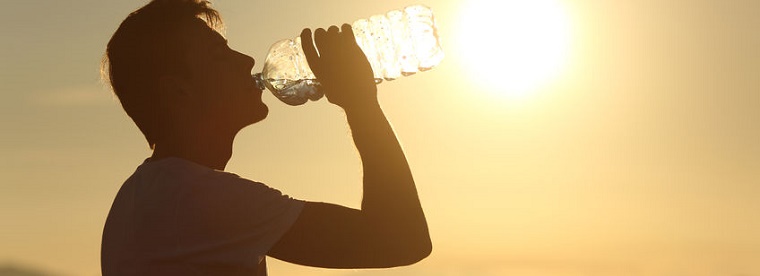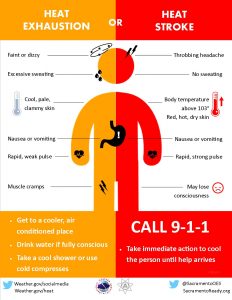Find care now
If you are experiencing a medical emergency, please call 911 or seek care at an emergency room.

When you think of summer, images of swimming, camping and barbecues with friends and family probably spring to mind. But while you’re out having fun in the sun, it’s important to remember you need to protect yourself from the heat. This is especially true since the National Weather Service is warning of a record-breaking heat wave that will push heat index temperatures over 100 degrees across the central United States and into the East Coast this weekend.
And the two most common heat-related illnesses to watch out for are heat exhaustion and heat stroke.
 What’s the Difference Between Heat Exhaustion and Heat Stroke?
What’s the Difference Between Heat Exhaustion and Heat Stroke?
Though heat exhaustion and heat stroke sound similar and are both caused when your body is unable to keep itself cool, they are very different. So it is imperative that you understand the symptoms of each, as well as how to respond if you or a loved one begins to exhibit signs of either heat exhaustion or heat stroke.
Allen Taylor, MD, chief of Cardiology at MedStar Heart & Vascular Institute says, "What to watch for is early symptoms like thirst, dizziness, but it can progress. If there’s confusion, nausea, it could indicate more severe heat injury - if it gets worse than that, it can even be fatal."
Heat Exhaustion Symptoms and Treatments
Often caused by exposure to hot weather or participation in physical exercise, those who are suffering from heat exhaustion may experience the following symptoms:
- Feeling faint or dizzy
- Excessive sweating
- Nausea or vomiting
- Pale, cool, clammy skin
- Weak, rapid pulse
- Muscle cramping
You will need to move a person suffering from heat exhaustion to somewhere cool, with air conditioning, as quickly as possible. Have them drink water if they are fully conscious, but avoid alcohol or beverages with caffeine. If they are able, have them take a cool shower or use cold compresses to lower their body temperature. Consult a doctor if they do not feel better within 30 minutes, or if they vomit more than once.
Heat Stroke Symptoms and Treatments
While you can often treat someone with heat exhaustion at home, heat stroke is considered a severe medical emergency and is characterized by the following symptoms:
- No sweating
- Throbbing headache
- Red, hot skin
- Body temperature above 103 degrees
- Rapid, strong pulse
- Loss of consciousness or altered mental state
If you think someone is exhibiting symptoms of a heat stroke, you should call 911 or get them to a hospital immediately, as a failure to do so can be fatal. In the interim - either before help arrives or while you are in transit - move the individual to a cool, air-conditioned environment.
In addition to cold compresses, you can also use a fan - but only if the heat index is below the high 90s. Otherwise, a fan can make someone feel hotter, rather than cooler. Finally, unlike treatment for heat exhaustion, you do not give someone suffering from a heat stroke fluids.
Heat Exhaustion and Heat Stroke Prevention
When hot weather strikes, you can keep you and your family safe by staying in air-conditioned buildings, but do not rely solely on fans to keep cool. Limit outdoor activity, especially during the midday hours, which are the hottest part of the day. If you do go outside, wear clothing that is loose-fitting, light-colored and lightweight, and take cool showers or baths.
Also, make it a point to check in on at-risk friends and family members - particularly those who are elderly or may need additional assistance.














